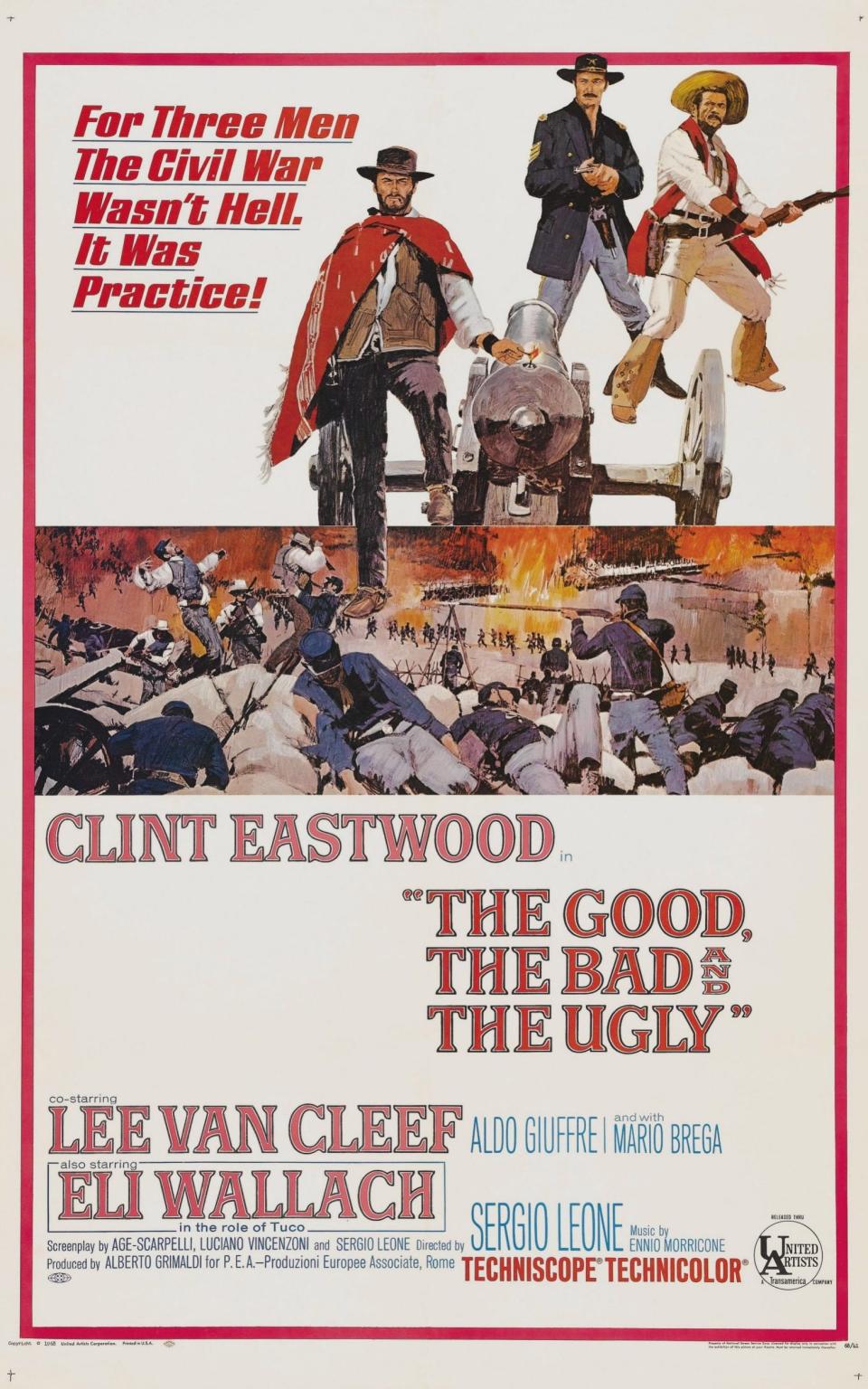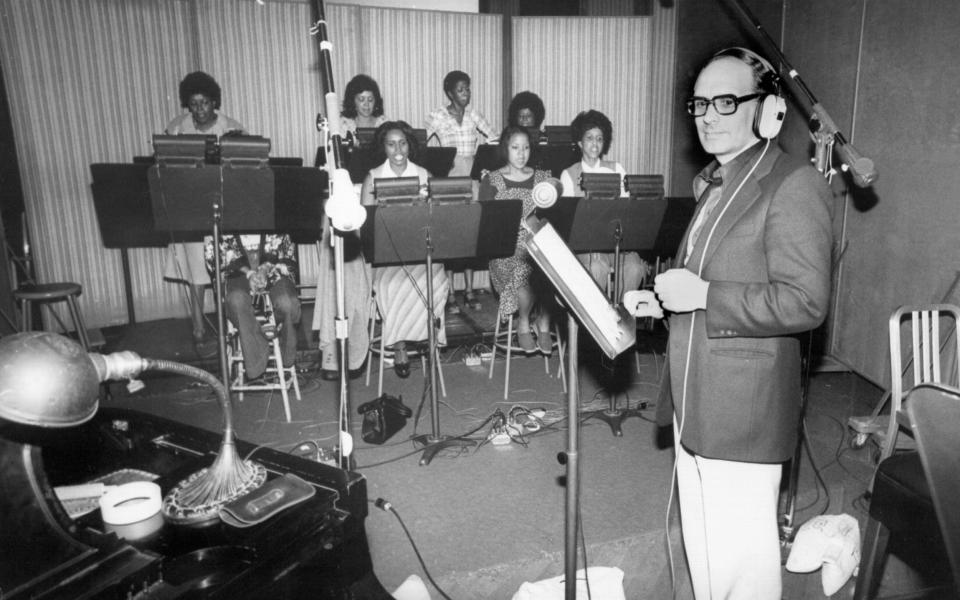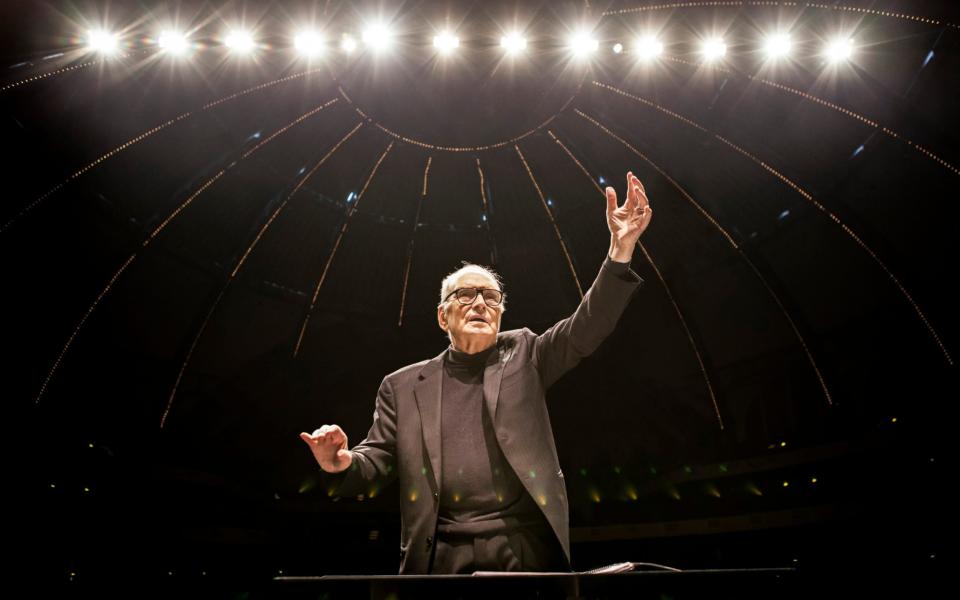Ennio Morricone, Oscar-winning giant of film music who wrote more than 500 scores – obituary

Ennio Morricone, who has died aged 91, was an Italian composer and conductor who wrote the music for some 500 films, including several of Sergio Leone’s “spaghetti westerns”. His melodic and evocative scores could also be found accompanying films as diverse as La Cage aux Folles (1978), The Untouchables (1987) and The Mission (1986), for which he studied the musical practices of South America in the 17th century.
From the coyote call that opens The Good, the Bad and the Ugly (1966) to the rolling wistfulness of Once Upon a Time in America (1984), Morricone’s music was always written with both eyes firmly fixed on the on-screen action. Far more than merely an accompaniment to the drama, it formed an integral part of the mood and atmosphere. Films such City of Joy (1992) featured dramatic swells, while jagged strings pervaded thrillers such as Wolf (1994).
Despite the endearing popularity of his work, he did not pick up an Oscar until 2007, and even then it was an honorary one presented by Clint Eastwood. In 2016 he took home another statuette for the score of The Hateful Eight (2015), Quentin Tarantino’s American Civil war thriller and Morricone’s first complete western score in 34 years.
He famously incorporated everyday sounds into his scores alongside conventional harmonies. They include tin cans, typewriters and gunshots – what he called “found sounds”. A Fistful of Dollars (1964), for example, features the chiming of church bells, peculiar whistling and the cracking of whips in its chilly soundtrack. Describing him as a postmodernist composer for his espousal of non-conventional instrumentation, one commentator noted that “every acoustic gewgaw is grist to his mill”.

His well-informed scores also drew from all periods of musical history – from baroque to serialism, and from Monteverdi to Stockhausen. “A composer has the obligation to invent and capture noises, the musical sounds of life,” he once told American Film. Indeed, when quizzed about his musical background Morricone would list an unlikely string of atonal composers – Boulez, Berio, and Nono among them – yet into their uncompromising serialism he added his own blend of jazz and experimentalism.
Morricone’s refusal to live in the United States – even though a studio offered him a villa in Hollywood – set him apart from the mainstream of Tinseltown. He also persisted in a somewhat perverse refusal to learn English – so he could flirt with attractive translators sent by the film studios, he said.
Yet eventually the critics came to consider such belligerence a virtue rather than a hindrance. And, unlike many film composers, he declined to outsource the graft to anonymous arrangers. “I invented the formula of ‘music composed, arranged and conducted by Ennio Morricone’,” he proudly told The Guardian in 2001.

Ennio Morricone was born in the Trastevere district of Rome on November 10 1928, when Mussolini was at the height of his powers. His father, Mario, was a trumpeter, while his mother, Libera Ridolfi, ran a small textiles company.
Ennio, who was a classmate of Sergio Leone at John the Baptist elementary school in Rome, though they later lost contact for a while, was composing his first music and learning the trumpet by the age of six. He never lost his passion for the instrument, which enjoyed a high profile in many of his scores.
By the age of 12 he was enrolled at the National Academy of Santa Cecilia, where he later studied with Umberto Semproni (trumpet) and Goffredo Petrassi (composition) by day, while secretly standing in for his father in clubs and music halls by night. Soon he was playing in recording sessions for the postwar Italian film industry.
“Most of these scores were very ugly, and I believed I could do better,” he said, though elsewhere he insisted that he only prioritised his film music over more serious composition because it paid well and he had a family to support.

In 1958 he took a job as music assistant with RAI, the Italian broadcaster, but left after one day; soon he was working for the record company RCA as a studio arranger. By the late 1950s he had orchestrated hundreds of songs for Italian singers such as Gianni Morandi and Gino Paoli.
However, the big screen was calling. His first full-length score was for Luciano Salce’s The Fascist (1961); by the time he had completed the music for Leone’s Once Upon a Time in the West (1968) – when, unusually, Leone asked him to write the music before filming, which was then played to the actors on set – his reputation was firmly established.
Typically Morricone would rise at 5am and, to avoid the hustle and bustle of his family, lock himself in his study, where he reputedly kept dozens of bars of stolen hotel soap in his desk. He lived in a 17th-century building bedecked with chandeliers in the centre of Rome overlooking the Forum.
Between his big-screen works Morricone continued to write non-film music, including a ballet (Requiem for Destiny), and Riflessi (1990), three pieces for unaccompanied cello. Classical performers in turn paid their respects, with the cellist Yo Yo Ma recording an album of Morricone arrangements. There was also an array of jazz and easy listening music.

Not every score was a success. His music for The Scarlet Letter (1995), for example, was rejected by the director Roland Joffé, with whom he had worked on The Mission – as was a score by Elmer Bernstein – and replaced with one by John Barry.
Morricone was dismissive of questions about his prolific workload, comparing his impressive dozen or more film scores a year to the output of Bach, who “used to compose one cantata a week”; he told the interviewer John Doran that compared with the great Johann Sebastian “you will see that I’m practically unemployed.”
His other film scores included Giuseppe Tornatore’s Cinema Paradiso (1988), Joffé’s City of Joy (1992), and Quentin Tarantino’s Inglourious Basterds (2009) – although they fell out when Morricone objected to Tarantino’s use of one of his songs in Django Unchained, saying that the director “places music in his films without coherence” – although his objection was also in part due to “too much blood” in Django.

Other directors he worked with included Franco Zeffirelli (Hamlet, 1990, with Mel Gibson), Roman Polanski (Frantic, 1988, with Harrison Ford), Oliver Stone (U Turn, 1997, with Sean Pean and Jennifer Lopez), and Warren Beatty (Bulworth, 1998, with Beatty and Halle Berry).
His composition Chi Mai (“Whoever”) was used in the television series An Englishman’s Castle and The Life and Times of David Lloyd George; it went to No 2 in the UK in 1981, and was covered the same year by the Shadows on their album Hits Right Up Your Street.
Morricone was nominated six times for Academy Awards (for Days of Heaven, The Mission, The Untouchables, Bugsy, Malèna, The Hateful Eight), but – save for the honorary Oscar, awarded “for his magnificent and multifaceted contributions to the art of film music” – he won only once, for The Hateful Eight, late in his career. That the statuette otherwise evaded him was a rebuke, said some, for his refusal to move to Hollywood. Nevertheless, he picked up a slew of Grammy awards, Golden Globes and Baftas, as well as an honorary doctorate from the University of Liverpool.
His film music stood alone even when the silver screen was absent. In 1968 the theme for The Good, the Bad and the Ugly was a No 1 hit single in Britain, while in later years he stepped out of the studio to direct concerts of his own works, starting in 2001 with the Rome Symphony Orchestra at the Barbican.
One such, in 2014, was cancelled after he suffered a spinal injury, but in February 2015 he wowed audiences at the O2 arena with a sprightly run through his greatest film hits in a show entitled My Life in Music that left the critics marvelling at his “apparently endless flow of inventive melody”.
Despite the widespread acclaim, and his insistence on always being addressed as “Il Maestro”, Morricone remained in some ways a modest man at heart. In 2004 he told The Sunday Telegraph that he was “satisfied with what I’ve done. But I still think I can improve. You can always do better, you know.”
Other interviewers found him hard work. David Sinclair wrote of their encounter being “a case of the good, the bad and the interpreter”, adding that “while Eastwood played the man with no name, Morricone is the man with no manners”, recalling a litany of fidgets, groans, stretches, yawns and brush-offs during his interview for The Times in 2004.
In 1956 Morricone married Maria Travia, who wrote lyrics for several of his works, including the Latin texts for The Mission. They had a daughter and three sons; one of the sons, Andrea, became a film composer.
Ennio Morricone, born November 10 1928, died July 6 2020

 Yahoo News
Yahoo News 
